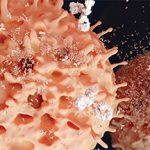
MADRID—Prevention is the ultimate goal with any disease, including rheumatoid arthritis (RA), and researchers here at the European League Against Rheumatism (EULAR) 2013 Annual European Congress of Rheumatology, held June 12–15, presented cutting-edge work aimed at that end, with projects from identifying who is most at risk to potential ways to intervene and prevent onset.
Prevention as a bona fide topic in itself represents progress, although Dirkjan van Schaardenburg, MD, PhD—who chaired the session and is professor of rheumatology at Jan van Breemen Research Institute in Amsterdam—said answering these questions will require a lot more work. “There are many more answers to be found for the questions,” he said.
Which Antibodies Indicate Risk?
Solbritt Rantapaa Dahlqvist, MD, PhD, professor of rheumatology at the University of Umeå in Sweden, presented work that delves deeper into the relationship between antibodies against citrullinated proteins and peptides (ACPA) and the development of RA.
She and her team mined data from the Medical Biobank of Northern Sweden, a collection of more than 210,000 blood samples from 131,000 people in the general population, who give blood samples in exchange for a medical check-up.
Researchers analyzed the samples from those with nonsymptomatic pre-RA, those with RA, and controls to assess the presence of antibodies against an array of citrullinated peptides.
They found that the fluorescence intensity of antibodies against fibrinogen (Fib) ß36-52, Fibß74, CEP-1, citC1III, and filaggrin were significantly increased in those with predisease compared to controls. Antibodies against Fibß36-52, CEP-1, and filaggrin increased gradually, eventually reaching the highest levels of all antibodies before the onset of symptoms.
The earliest detectable antibodies—Fib∝591 and vimentin 60–75—increased only slightly before the onset of symptoms, but more so after disease onset.
The risk for development of RA was highest for filaggrin (odds ratio [OR] 11.64), Fibß74 (OR 10.68), and CEP-1 (OR 6.27), and those risks remained high after adjustment for the presence of HLA-shared epitope and smoking, suggesting an independent relationship for RA development, Dr. Dahlqvist said.
Researchers also looked at the risk involved with combinations of antibodies, HLA-shared epitope, and smoking and found that the combinations including CEP-1 or Fibß36-52 came with an OR of 38.8 for developing RA, compared to having either one individually and being HLA-shared epitope negative and nonsmoker.
Dr. Dahlqvist and her team have also evaluated the role of salt intake. The work is unpublished so far, but she said the findings have been interesting.
“We also find that high salt intake in preliminary analysis, in interaction with smoking, could be of importance in the development of rheumatoid arthritis,” she said.
Complex Model of RA Progression Starts in the Lung
Anca Catrina, MD, PhD, professor of rheumatology at the Karolinska Institute in Stockholm, reviewing work at her center and elsewhere, proposed a multifaceted model on how rheumatoid arthritis begins and progresses.
She said it’s “a model of rheumatoid arthritis onset at extraarticular sites that start with the genes and environment, leading to changes in lungs, gums, gut, lymph nodes, [and] generating humoral immunity, but also local changes in bone turnover. And then, possibly, the need for a second hit,” or trigger, for the disease to spread to the joint.
Work at her center has reinforced the notion that the lung might be central to the start of RA.
One study, consisting of 105 RA patients and 43 controls, involved high-resolution computed tomography (HRCT) and a test of pulmonary function at baseline, with the same assessment at six months.
There were more parenchymal changes on HRCT in the ACPA-positive RA patients compared to both the controls and the ACPA-negative RA patients. There was also much more lymphocyte infiltration in the lungs of the ACPA-positive patients.
Further studies have found that certain citrullinated targets can be found in both the lungs and the joints in RA patients, making a link even more likely.
Combined with other recent findings on ACPA promoting bone destruction and links with periodontitis, the search for RA’s origins is starting to paint a picture that includes many levels or steps, although those levels might not always remain distinct from one another, Dr. Catrina said.
Asked whether the activity in the joints and lungs might develop in parallel, she agreed that might be the case. “I am not saying that what I am saying is the only truth—I am saying that there are different truths” from which the ultimate model has to be derived, she said. “I think the lungs may play a different role in some different stages of the disease. And the true hypothesis—one, that the lung will initiate the process, and the other one, that the lung is just a part and bystander in the whole process—they’re not mutually exclusive.”
Patient Characteristics for Treatment Selection
In another presentation, D.M. Gerlag, MD, PhD, of the Academic Medical Center at the University of Amsterdam, discussed work aimed at assessing who should be candidates for preventive treatment and exploring the use of rituximab to help stave off onset of RA.
The line of inquiry stems from the idea that “we have a therapeutic window of opportunity. Although we don’t know when it exactly starts and when it finishes, we have a feeling that when you treat patients that are diagnosed with rheumatoid arthritis, actually in the first few months after the disease, that we can be more effective in reaching remission and preventing erosions,” Dr. Gerlag said. An extension of that idea is that there is also a “preventive window of opportunity.”
One study at her center is looking at just how often people at high risk end up developing RA without treatment. So far, a cohort of 55 people, either with rheumatoid factor (IgM-RF) or who are ACPA-positive, has been followed for as long as 47 months. To date, 15 people, or 27%, have developed RA, and they have a follow-up range of 6 months to 27 months, with an average of 13 months.
Researchers also found that those with a BMI of 25 or higher, and who smoked at some point in their lives, had a hazard ratio of disease development of 7.5 compared to three other groups: those who have smoked and had a BMI of lower than 25, and those who have never smoked and had a BMI above or below 25.
In PRAIRI (Prevention of RA by Rituximab), researchers are planning to follow for four years patients with a high risk of developing RA. Their hope is that a 1,000-mg dose of the drug in the preclinical phase of the disease will help delay or prevent the development of RA.
So far, 95 patients have been enrolled, with 74 getting the medication. Sixteen, or 21%, have developed arthritis, with the average follow-up of six months until clinical arthritis developed.
“I think that prevention is better than cure and that the true window of opportunity is the preventive window of opportunity,” Dr. Gerlag said. “The question remains, of course, who do we treat, when do we treat them, and how do we treat them?”
Thomas Collins is a freelance medical writer based in Florida.


